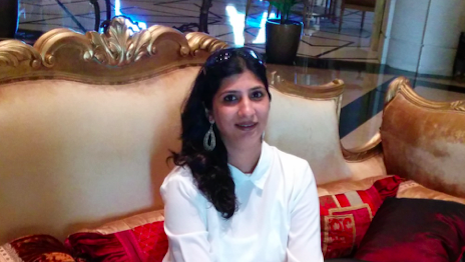By Sheetal Jain
India is the second-largest textile and apparel exporter and the largest exporter of hand embroidery in the world.
Textile exports from India are projected to grow from the current $44.4 billion to $100 billion in the next five years. India exports most of its hand embroidery to France and Italy.
The textile sector is also the second-largest provider of employment in India, after agriculture. It provides employment to around 45million people.
Threading the needle
The Indian textile industry reflects the country’s rich history and heritage that dates back to 2500 B.C.
Indian embroiders – also referred as karigars – are known to be among the best in the world.
These craftsmen showcase the culture and traditions of India. They pass on the knowhow and techniques through generations and weave the artistic fabric of India. They are the backbone of Indian fashion industry and custodians of rare art forms.
For more than three decades, several global luxury brands have secretly subcontracted their embroidery work to Indian karigars.
These brands never gave due credit to Indian artisans, who were always kept behind the scenes.
Rather, the association with India was never highlighted by these brands as they thought it might demean their brand equity due to India’s perception as a country producing low-quality product.
However, the fact is, from Alessandro Michele’s Gucci collection, adorned with tigers and butterflies to Dior’s embellished saddle bags and Jennifer Lopez’s jungle-print Versace dress, all were handcrafted in India by the country’s coveted artisans.
But, unfortunately, instead of recognizing Indian artisans, they were deprived of basic wages and working conditions. In spite of hefty price tags for luxury brands, the condition of these luxury-producing factories was no better than factories producing fast-fashion brands.
Even though these haute couture houses have been boosting about their corporate social responsibility towards people and planet, the reality looked somewhat different and ironical as compared to their claims.
After Bangladesh’s Rana Plaza disaster, as surveillance of supply chain grew, luxury brands became anxious about their ties to India and initiated ‘Utthan pact’ in 2016 to uplift Indian art and embroidery and ensure the safety of artisans working in factories. But actual implementation and results fell considerably short of claims.
Major international brands that considered India as a least-priority market are now extremely bullish on the Indian market.
One of the key factors driving this change is the fact that India has the third- largest number of millionaires.
Time for new look
Euromonitor expects the Indian luxury market to grow from an estimated $5.9 billion in 2022 to $6.1 billion this year. All international brands want to be part of this growth rally.
Dior is the first international luxury brand to do an official calendar show in India. Dior’s creative director, Maria Grazia Chiuri, collaborated with Mumbai-based Chanakya school of embroidery to showcase the label’s pre-fall 2023 show.
The Dior collection displayed rich Indian cultural heritage that included 25 craft techniques such as phulkari, mirror work, French knotting and kantha.
In the coming times, we will certainly witness many other global luxury brands following suit to build brand awareness and an emotional bond with Indian audience.
In the future, skilled artisans must be given their due for the heart and soul put by them into their work. They deserve to get all the limelight and visibility for the work and effort they relentlessly produce to bring life to lifeless objects.
The question is simple: Is it fair that these artisans are paid pennies for the masterpieces that are exhibited in the luxury maison? Absolutely not, if you ask me.
It is high time now that Indian artisans should start commanding premium pricing for their impeccable, absolutely unique and high-quality artwork.
Although haute couture houses have been historically sourcing intricate hand work from Indian master craftsmen, now is the time for Indian designers to put their best foot forward to showcase the spectacular Indian artforms in the global world of fashion.
Recently, Gaurav Gupta, Rahul Mishra and Vaishali Shadangule have made it to Paris haute couture week and astounded the world with Indian age-old techniques and traditional embroideries fused in a modern avatar.
INDIAN WEAVERS HAVE immense potential to gain global appeal. Indian homegrown luxury brands can ride on the strength of Indian artisans’ rich history, legacy and design capabilities to create global luxury brands.
To achieve this, Indian brands should communicate the country’s true legacy and strength in the most effective manner to global audience. It will not only help them command a premium positioning, but will also help in getting due credit and recognition as well as financial gains for the thousands of Indian artisans.
It took almost five decades for Indian fashion to reach Paris Haute Couture fashion week. I think India’s moment has arrived and there is no looking back.
Sheetal Jain is founder/CEO of Luxe Analytics, Delhi, India. Reach her at bardiaconsulting@gmail.com.
{"ct":"kQDUYCKIJeYHL8vpVLTFhQSUzZr9KWZ7CW3CouZyE3IMQihTFdSURHX7F+LR1YQpd78QIOhs9Qtg\/osyad0HNRMl+kPiUaggfyjlymUUrB+oPDJWwx6dV9kmedhqwBCqPGfA5XtMmeStXv0gLCXXzXA+8uuhdKkI\/mqD8285aoIDUOAxn5\/qY+IXaoSxPIGRrt\/VtFHGlxvx1rkPwQP8ctqwHJgjbWlP0pIvslEXho7x7VlQJa16IuIW9kHPZR99QDdYV\/YqL7fH3xByjzWO91V5VUTMa+ciAjnS3JjF9XhDPCWNWV3pwKVNVSm6ba2j8AiwMQgOIkRgw4u\/Mt05VEjZk3edTt+5S4EB\/Dr6doWRCZsVDCbIbsCPbZqxhkXaQtdCTGpraFLJgANXv+fWHrVztrVfRHU\/nAh6\/zDQZ8VMvssYWF\/eLn9VE\/JQSQQYxdJehbIgm7uhVj2y8L3eLPkfQA3paCUP5x1ZvozTMiqDM\/qZcol25hlewDHXKQ16fXjr3cMFYwgtJQQ9LwxXSYsx01OXHoYT\/WPbyMi1CaeNnITjHqcJe23id7J+7e4bTiU2Lmc\/kJFrKODksh1XIE0NC05ial7fXPHq8zNsJSy9Amc12p3u3bFkabJxKiTYB64DZ9GgRnv8noU9feyLXPe4mzrQTt3Yy04aXjfpu9Yw4FXH+wtAwaPl+yK55lXo3g0A9ssZgPlqmZkbyk0+SGRnXN\/TbHH4083QDzHY8nSz9p6wfWMDAe1E2vGkIQiP0\/YBtaBDcxj7MhE2WR9+o8\/2acsyA3hZ3ZDWe0CRNIGsb2iuycYh0xbGPkEnrubOU\/QhVEVzrmnR8qcq1InxIUg8PkQrsUO5UZ0KtsrPhn+oO\/oWOFXmepR18Ddx3cMSjs6WPamzbmtJD0qeYuplj12ANfgEG+LYNo7btSvan0mNQYB9T+EMgk9iGaee7jn2Wlc7q\/Dtze0IISx1Lx0xKEsrIPIDrp5ZLXaCeXDrcQEU78KS4qwexuPEYWYjlhkHoNs61LTb6673noRRG7TZqkXcfSvHwOaXJ0bz+UxbO9yik78XT1Vb1KfHYJ5hvqYdzpae7QUFUgpNOOslZvuJC4qkmiD0\/5fYnngIP9jLwBwiXNnP1xWT6cduKVcnTjNvxnt7ILnlfKTP8gu3lWNqT\/UaP5ZktOpvDwB397Ueh3j\/wTirrc5UpPugg2awODHiFf8qHSdGGC50KuM6ejsEQipgcTEpeNDqxCnImRDFJ1Cg0Sto1d69yecHs5Pr8pcsiFVohnY1jXr0y3XJi16h9TywOPus\/mriw6sqpFINE5FpnNU99kKF\/iHaFQrLX+BmC\/XtPGFm\/Gl6w1UKy9JvnijxCW6PWdEsvMvftCaOBnHDIbZA1eXyc+1RrgcESaLWp9qR3LeXZALu9ZKKm7zyfJOtouPb3K\/BZBVgr55N+vVW\/T+tGjLM0xfZ+guJmLGB24gf2DTZVSpPFLYxv0MjKXZnklRCjraxwI9tB9VYQwzCScpAns1CZsTyow11cVz9uaHhRnBKosQteUb\/p4XT15H\/KPjGqTIBjJfd6Li82aw7w9myXCDzTmij7wbMyqLS1RA1X7MSuFw+E3Q5jNgm6NKbPN3yu5ekv+CHhr6kNSjHxn\/QWRFxt6Mrxhe\/kznZ6qZUlSqbS0wFXar+Ng3g0fPIu2Jds1kqZoEEQMNoVNlWF6KiUotO6chiRcqWjy89WegeyaCBUiLq\/tI+UF2EE0lsWKl+IRVv9HdN2TvpQ4SwDZyJvHmxzwuh5qLe0trn\/EK2Bkapa4\/fc\/XxK3990vwXCR7c5fc8qDD6MchvRHtAzs8vRNzmtl1sMj6BEOGjdJ8aTbwgIr5\/y4zlnes1j04rPYMNuo6FF\/XoEk\/+HFxvfjg\/Z+Ja8MKfxWoMm6ohGtn9n8UUXOnpksaUE3MxL5jgQ\/08hRUOa7S1Da51fOK\/pHI\/T9Hj10PndHvr7SjdOKASxHA3CWsnM2pMbYaelxUuJKDiiIqS8mDnBk+OlesjMHHDV3LnOUoRUlJUGaYprhr4R1qnuJtbzWX0DrUArMJTW0LEZD9YD7NX29nSSq0fcSS\/nEFRD\/lBdpRYLZ6PjmIG\/daaWZzdHeAEznxAbVK5PP6HS+F8AOoECpGcPwGhDUTw2F9nW9apSUuJ5YKKLoecIXfTvdTDF59YUHIpueyLB5TdHiEb\/5+YJ22qihfrDXc4rOPDcb+3Q9x6dNUopnInd8PLbO3wQl7Lm1+DK3Ol\/ne7S\/v0CzQUyITSzSv3cL7LPa96sd1Inthk3I+hqu0sMqBYH70E6MIDOVBa7R6OqL85Gf38TbSEJyMsktwtdUVsFNVFQhJRWh4icYX+bvvS8qzDF1f8xzdRZlvbUWaAqDU1GSRV0dZItoKX1GD9A2hjeFmRCIOw\/w\/\/UQZ\/OJbCwCdCI3Mb3wQR6nkARm+k8+9rAEVu2WZAdWl+VIpIQYJ9tbMWcngEHDPkQXQZ1WqXb42SdeqcFI2d9KStfipyBmJ6dfRMM46YiL09CcLa+huUeAy8F1tWsXKBZdLcqrRcozlh7E8gNYBivj3PSn1tNpAc6vs6pIVaulR2c3I7A2kguFWqGktlCCMPEXAhJyW6cmyz5\/JAv1hHUTUBgoZHQAvxkAhNFWZOo2K7Z3zc\/0A771Rp+Cji1qr32NttQFn5w\/RGQzU0QXI9o3Un+O7LNcVjd3hIu2eGniGd4Rq1gJ50SuowiIBLZTGkthCf\/cft2DYckosWOgrulR3jvDsysoc9vykJyFXCpr5ECKwtb+TkO7+rDe5CiooYJuPvyjDdU6axZBpP2sI44l\/PALgwPcMJMGVx5XVrGnruFFMVcPyGZBvpY9oKLCEISR9ogHgScqc0pSJ4M9xNGoV\/O++8S\/Ee875AQaDWftTcomMWHs3ykEn\/40PY42IkmQam8aUMhLZ\/xwdGGgXPIEoBuv6x2MRzA891bFUYz4N1dgS0uu\/q7Wa7z8\/O8CHmJEEWQFE591kMeOKAKPKKZX9lOKu+lIWnH+gBK6y3rG8PNgK4BNP9UvDnZ\/2upExwY87+vh0YqSLLdlzYwhCPVFX+F8i3fgVaeIYOcDY6+KZP32+RNlV6f7s4tPdMP6Lh7pd+5lnhPfvQv9yq2DTkeFUP\/C6HsJW6rqosik40EOK2RKEB\/nutHeUEkNpgMD8Yb\/g6CCWq34yoqvngixT97mc9zzrPw5ygUBjGjEkt7zhzF3v5w4KqAUgQEkdAfaxBX\/Fc\/NLSd0xF6iqFT6TU+fw\/1P5GeC682BAhSeF5JERd2DjcQ8xy7nqoFdHTF2fj3wZ\/ATmJ3S6H4ESlVsZlBQ0vUtm1PFMadC4Rs2JnbAPcPLFHRJGZ8khmjvjVIMyTbn9AW3V5+u3xrfo3AKyUeyTl0RsoJyL9lcLiwQHXBlq7MR5Q0pAg+J+Yd+An++shGGRHsl09qKZWPsjydY6lTONi0iQAzw14lGq1g07ndVFsDXVqhj4PzK1d9oaa6oDAhd\/B3FWALvhYJJHbhlimpbso\/6cZl2GP1c6rb7EAlor3OSA7gf7GDB8bFEQP2LcPXe66FVhsICuAxdcanpwiXaZRuSUCOvh05HYKucb\/gU3zlKY8NjLj8YZm5tIlbuuNcPPe3PYsczYryckOi88zdaBz\/b\/yMZ+14JF\/PLFb+nwlGRdyCsRZ2ZLjln0nQ6lh76AWC08ZOQw0U7phea2QKoNXtAj6bgtL2LgIOo7EbU5OTcwo2pnhmaqok5GN3NzSY7Uwro0c+Mz3v3Zoo8sGGzNXUugLj0aeqNLedhSp8y8gazMEOOP5yZKwe82fML30k7WYgfyXklikvrAbJp8Q3RlXmuHe0agD973UMLJMBrOjQnyF9VZTmneknG9m2Dtsi9Qw6YwkP8Xh5GvseXpQ6\/Uui7PD+MCAz4daZxK56mK6DlUmBhw6oef\/xrxfojEznZOhS5tmCA3boZNTSmT5GSjtVcLnAWSQaiX4Key0WtBJDt77\/dEqRvviFPabNaywOqMl4GNx26bKRVwVEAHplMn4NBS\/9ZkWCBT+gy8peZ3Ys4hsp2+IhSaGYTOLWCrG\/Cdd7IJDSSW7getP6qwCw\/qzKtwT8gx\/jDLB5TFznaBNXV8j7r+YM+0nX2JZTIDGV4fTHn8G33HLm+m\/2KWuml2phSWHK55GPGJoDjkQlRItBpcWXdqMa9ss5fMxSAfhCozJ6SjmkruPumtTk9CuJO3+4BJqoCUzimszB8Xl71Z4A\/CzSMlvKx8pvoQwdcxbsRJRG9ZHzYigHYAZcvC\/FLuDobk8WoZsP1a4uuajjx+90r7OiZey\/qh2Be7kuseWQ73FAvlInE7JXP2+Cb6lyKwc6+H+HjOQjJWocvaLQOcWgabbx9nThiganb5sKM3dbYcbSUhRB8Zl3ZXvAIhM2ZH3JNspopxIpYWU39bfWTNeVcjjhFyauvCFO7QClpuoUAv9UV2rlMDlc3jpAp2yp3d7hMB1ZkOlEpadZU9xdNlYX9XAmMFwwvg\/gCk6AEAIxoWJKq7+LXLK4uU9\/SoRB3EU\/ODoK1UmYJp2euAz08IwLyjXbtUmnsSpCaTa0eCCN7WzSzWsPQWeBptyDZeKxQ1iKrdWD+pyE8g8PDLPlyxKT0ygdjUjYF2FMiXvjo5LLHFiZPfLNCtpE17aYxd137iMW4eX3Rh0CosDYEu1+nJUHqZbMiWLsVTXY98LYyl4X2Fj19aM2gz8fJlWIzChCJxLV5PzTbY5HajYsbuVeujJiftpdb63OtfV3\/HyquzWkLPsHEg1zeAgOhI\/Wf6PqACaCmjINpDl8HKC7rbgPfcM3GzipaKy+l9p+MqFTu59pIR5r8sLNOjIODg1y7SuLWKCFLdcrvLKHqzfcrDTGVdXQYhcSOHR9D3MBhQxfk78PVJ\/yv33jsNeU2BRaDcD8STGCByVoYDFWZHPs93h+z2rL\/3CU7DinYJKvrssUcT7gmus9RJg2KXXf3+PflDXbSAw8YpmsNBm4GKcYVB+q1\/0x8Zo\/6ZHgrDEj\/uxb1BNyKuvjCCon2ZmewmKH1hk0qAgl8txOfrJXJC43fmdT2W3IXgi4BtRAoV9bcQ5OMoDNIaMO1uHhRzi85XrSLodSgVFhecwTbi7JkPv9XmcJyiNQVTPx82roQhFxIa+fJBHdQwfS+OfQcyX3fukkvDbjm0UD3ENJh488JiWQvyVBOHjDeztYNZFjKXhxH3Ep\/\/vvCCK5x2\/8yRmMy\/EPbTsX6Z4uZhMRqTTDpVFHVJfG1W7Jit7w9KL+q3yreKUEesVJ10blZbSw6HDbfH82drw3Cdnh\/+etVShvM8\/wgtBzH\/euk+BXIL3raT+AGPb1GhOmlFVaShlTHuqaA8R3zyikp6WTTuE\/Ot6TR5ZEvpe0Jmfa3S6lMEz4GAbNDe8h7R8D5vDpscPOwpO9UO5onIhPfsGLKBenSDXzOlZlyo6AwC8KckiseNRfEvvv7car6XhjnVMHtzJ3p8eoqn7w0F20k0dYtnBeKLbP3mxNEwa7JWSFXXkXexfRv05uF+PeiZJqtd5DWSF5LulTzMp0Bj+dhA9jbDwNpPZSFiSTi+7CtQ1XBPZjyeV7qUaCbrigcVmHHIZ0VVKDh7suCEIeuX94NhYBBoLsPxCKu00V8KfkVc+uXvac3OOzVwRVJKG8Ioet+Fsm9BKYFlQ9lbeNEuUke2GQJlIFY7pzpo+00quOal8F4gs1+2pZZFgpW8N1cZZsIMRpq\/lkEznII7XsAdya9WQXX9vYZ41LryBAcisQ\/vkvncrMZ847rBrw6JKsCYpI5Ih+v\/QVYw1vnmZhdb7312xG4BBHnmPQMpMa2A4RVpaqhh\/\/88TRvbD5xFqaXEY9aOQ47FMjOON\/FX+Yzs3+u8qMG+kMtK14\/XfnIR9wNn08nEAFl1KN0eZwRpevx83PHivgCdcjrqjyNs4mIIWBYENNswtyjG\/odZb6c9PjQMxbBboMSuyaOIFjQNZY1lW8Q4AkRZHYepI9R+JgKou9SddA6yD8PuSrYcgwqTeK2BRQKGYi45M7HnY0iGOCn\/LWdps0ui\/Ie69XjLaQMLW0vxnk2KRhJcs9WkrKxKRSHDIHpwR4hDLSQeYW1eOcR5sGTkR2erzU3UMBxfX02rkKbEitC9PVOChWJ0F0VYx6pyssPrk+ZBGkV\/NceVMLQxFwuhUTOJvNppk5CbqJLEnxcnTzRE4LUBzSQcVhf3036TN0Qu6UwuMpDKseRPzxY\/z532BEg7dQTvgTohb2GsUBurzo8XXma2yvxr60Zog6RL+vMSQ8HgJXG6xbnH33tUwEQSZv8t4eG2cG9vq3QHh5kj4KzE2LSwRYFc8cHBnvUjr2g8+vIFeSRvB9N2lnA+Qsil9kg1a1BCs37eG+yCb7hUuusm0qU\/aj4n+CysAivva5rnguJ3dLOwrb8uKxG0X3jdnf+TdOL\/E8qsTWK1c\/09kIftiS8TRzHD4yqAJ5BFJ\/aB7CTndxrE7n\/kv4+2qiZxYXKeDmxqlP3y4U+PgvciY91iqX8qMn7jl83hpPhuFys+79mzeH696NV9zNgWMzNUugsxFBbEQRdcLJJB+qjUDZnxj6zvHn16DvQaseGEDcEjC5ldoKONyWNpkTMkwkFvpF8FM0tM2cswMa\/LCzAGcmI1e0O6uxLHs1UVUrel9g77RRjLI5\/\/tNnRi9S7mreyJVAaliZ0iWduFplnyzyARTWwAn3eerU2XdZTe0KEQMuyX3fKopAHmgnaP2jSMxXWxdRtBljLsNhEwkSmLBLPjR5kHCI0V65s9v9Y3r5wi43Jmvqv3usZRq+O+fk+3xBovimcrJDuMeOY1VAie9OBsRopwrv7iSZyoJIlqElhedw4X8WGTRUv\/cZxewOUSFQHfFR995jfu3dcCH3one22l5w+cP1x4lDpNvzz5VPHCSfbQkZ3LM14\/JxN4TClKQX0Aek92CCnbSmHZqUL1iPsab1joYUIBt5mUjiSCwsxGMWgmZDTqAlEwgINONjm+0MuKzVFQEl\/jps+UGNX68YzGPiW+fWkwTyMLOa+9NtRKES556E5lNxhMd85IlnSRp\/vATiF090SaYc4vBvKR+9OxEWg0DaWyaELpD01EZYLNffW0JN7h3+oGYnxgQY\/HIuWt9IbXq1kyZpcM0OdSwLmGbRJC2zIgwaz\/8Y17nZAo8uu\/dvDtcmBvH2WR4E54dOwRlcQUKWxvFInUNRG2SYKoU5KVvfafKbG3iYvDouQUyv7oWVG00uaGg1V2fYU+x4hcCtsfYr1HjDgnfEzXz3XXQJbkut3LI9uQ4on02u2mik5TPI+\/lHp1zLe0CBan7lfMuYFNNCElzsZBMImWwSCx\/VQEck+9BbXDnP6rtv5g407uteSJUggITnPcjXRQi6KX3i6FOa1LC6OpJFw4lAl7iY3oFNGzziov+uVo8ZNBblexzmkCVofVjUomqVlHyYm5uKJMa7UiT5eRy0DJTsE51UOyBnnkz+ybYgDZCwAsmmZBwhi82imS39opqKhvvELG7L8QOZ1FG0aGrVruXd1EdA1yRtI05Z+yysVD7vViRqq1u\/+q5fRP6Ds\/APNsduOJZB89WdGCOU4RqY+bxEHpukEpmNG6s2jS\/IC85nP6qhOLedML3nTme7SipMheaLGU4+JDr3TdweHEyy6GISG+o4NZjoHGmbDDS\/BDeq5kX\/mK0fKSLfXnbr4P3I48cjLECvkKNrvOC5tyxS4UmRC+3JyDORsLLoi6fD5y\/S86DoDeP9PEG+vtPH+MIyASURis0Ppd013XWmn24sz\/bfq3HlLjaIcgFrU2L2+LpfSECOtNgGmJW7jOCrWFum9qmvD5OdmjCOvRvBbK1STtdxWVPwRjZj90MAgcOEcuyypVZLsTYjuo6AcLKN\/8X2S2fUR194bzgNztoxPTV+IP\/VnPhij0t+y8D\/SqhDskz4kNrb7z2j3IrpRi\/\/0UDal7IQZN","iv":"3901faef641c7d32b64ffef89a6f850e","s":"24309298a345f218"}

 Sheetal Jain is founder/CEO of Luxe Analytics
Sheetal Jain is founder/CEO of Luxe Analytics